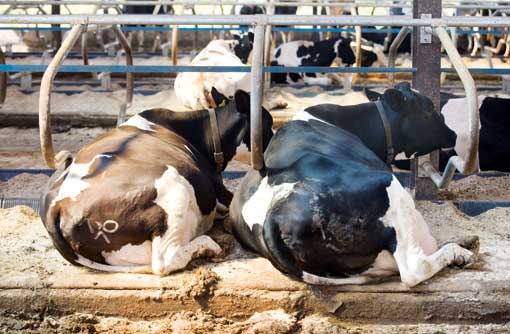Which bedding options are best for dairy cows?

With cost, sustainability and cow comfort hot topics at the moment, it is understandable why interest in using recycled manure solids (RMS) as a bedding material is gathering momentum.
The bad news is the jury is still out on whether the practice is feasible in Britain – or even legal. So what are the best alternatives in the meantime?
DairyCo’s Dr Jenny Gibbons says it’s worth revisiting the evidence from trials conducted over the past decade on bedding options and how they perform in terms of comfort, hygiene, cleanliness, welfare and cow preference.
“For a start, cows housed on mattresses or deep sand lie down for up to an hour longer each day compared with cows housed on hard rubber mats with little bedding (2cm),” she explains.
“In fact, lying time increases by 12 minutes for every additional 1kg of sawdust provided, 10 minutes for every additional 1cm of sand, but only three minutes for every additional 1kg of wood shavings.
“This will come as no surprise as it’s well documented that cows prefer softer surfaces and spend more time lying down in well-bedded cubicles than those with little or no bedding.”
She says deep bedded sand is by far the best at reducing hock lesions and rubber mats the worst, with mattresses performing somewhere between the two.
Deep-bedded sand cubicles create a lower risk of lameness and in some studies, halves lameness incidence compared with rubber mats and mattresses with little or no bedding. Sand also reduces claw pathologies compared with straw bedding.
“They also have a strong preference for lying in dry cubicles. Wet bedding reduces lying time more than any other feature of cubicle design or maintenance, and significant reductions in lying time are seen when bedding drops under 60% dry matter.”
Sand and straw improve the physical cleanliness of cubicles compared with sawdust, but straw and sawdust register higher bacteria counts than sand (the major pathogens associated with bedding materials being Streptococci, coliforms and Klebsiella) – although this has had no significant affect on somatic cell counts within these studies.
Dr Gibbons adds: “Interestingly, when given the choice, cows choose straw bedding over sand, but this appears to directly relate to the cow’s previous experience of sand bedding – extended earlier experience of sand increases acceptance.”
Deep sand has long been a firm favourite in the US, spearheaded by work carried out by University of Wisconsin’s Dr Nigel Cook at Madison.
He says sand is the ideal cubicle bedding surface for the dairy cow because it limits bacterial exposure to the teat end and provides cushion, traction and support for the cow when she is lying down and during the standing and lying process.
DairyCo study
DairyCo has commissioned a scoping study with The Dairy Group, QMMS and University of Nottingham into the use of RMS for bedding in Britain.
The study, which will be reporting early next year, will help the dairy industry and government regulators better understand the potential implications of using RMS for bedding under UK conditions and its impact on public or animal health.
From a survey of 176 farms in Wisconsin, sand-bedded herds carried a benefit of 3.2kg milk a cow a day and 1,152 kg rolling herd average milk. Sand bedded herds also had lower lameness (11% against 17%) and lower somatic cell counts (214,000 against 227,000).
Despite this, the inherent slurry handling difficulties found with sand, not to mention expense (unless you happen to be near an abundant supply or can reuse it), puts many off. “This shows that an otherwise perfect material may simply not be practical on your farm – they all have positives and negatives,” says Dr Gibbons.
“Some of the infrastructure needed to manage sand in slurry could make it prohibitively expensive on smaller farms; others may have an endless local supply of sawdust or shavings, for example, that makes it unfeasible to use anything else.”
There is also a huge variation within the range of mats and mattresses available. “Look for comfort and softness yet support. Make sure you avoid the ‘half-deflated lilo effect’ – try lying on them yourself to see if there are any obvious downsides, then carry out your own trial – your cows will soon tell you whether they are worth the investment.”
